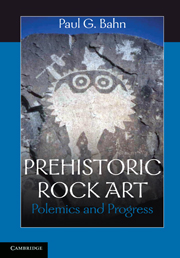Book contents
- Frontmatter
- Contents
- Figures
- Foreword by H. C. Woodhouse
- Acknowledgements
- Introduction
- 1 Art on the rocks
- 2 Myths and meanings
- 3 The emperor's new clothes I: sloppy tailoring
- 4 The emperor's new clothes II: fashion disasters
- 5 Location, location, location
- 6 The votive motive
- 7 Mustn't crumble
- Conclusion
- Select bibliography
- Index
- Frontmatter
- Contents
- Figures
- Foreword by H. C. Woodhouse
- Acknowledgements
- Introduction
- 1 Art on the rocks
- 2 Myths and meanings
- 3 The emperor's new clothes I: sloppy tailoring
- 4 The emperor's new clothes II: fashion disasters
- 5 Location, location, location
- 6 The votive motive
- 7 Mustn't crumble
- Conclusion
- Select bibliography
- Index
Summary
Rock art has often been ignored by archaeologists because they do not really know what to do with material which is largely undated (and often undatable) and which cannot reliably be read or understood. In the early days of research, the images were often read very literally, and this was certainly taken to extremes – the classic example, of course, is the ‘signs’ in Ice Age cave art which the first researchers assumed to represent actual objects, and gave them names accordingly – for example, ‘claviforms’ were thought to be clubs, ‘tectiforms’ were thought to be roofs or huts, and so forth (Bahn and Vertut 1997: 167). Nowadays we are stuck with these names, but they merely describe a shape – the ‘signs’ are now thought to be abstract symbols of some kind, perhaps ethnic markers.
Many images in world rock art appear readily recognisable to our eyes – although, as stressed in my earlier book (Bahn 1998a: xxxi), nothing is at all certain in the absence of the original artists, and that point should always be borne in mind when reading this or any other book on prehistoric rock art. In many cases we can be fairly confident in identifying human figures, or different kinds of animals; and in addition, as we shall see below, there is a whole range of objects, accoutrements, and vehicles which can be studied.
- Type
- Chapter
- Information
- Prehistoric Rock ArtPolemics and Progress, pp. 32 - 66Publisher: Cambridge University PressPrint publication year: 2010



